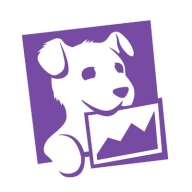

eG Enterprise and Datadog compete in the IT monitoring and management category. While both provide comprehensive monitoring solutions, eG Enterprise excels in its specialized focus on Citrix environments with deep visibility, whereas Datadog offers broader integrations and advanced application performance management capabilities.
Features: eG Enterprise offers a unified dashboard for monitoring diverse environments, particularly strong in Citrix environments with detailed insights. It provides end-to-end monitoring across all OSI layers, crucial for identifying issues before affecting performance. Its diagnostic capabilities efficiently resolve issues, saving time and costs. Datadog is recognized for its synthetic monitoring and application performance management, with features like distributed tracing and session data, which are critical for debugging. Its integrated capabilities offer comprehensive visibility and insights into system performance, despite a more complex setup.
Room for Improvement: eG Enterprise needs to enhance its user interface and expand integration capabilities, especially for containerized environments such as OpenShift. It also requires more flexible pricing and simpler licensing for smaller businesses. Datadog's extensive toolset can be overwhelming for new users, necessitating better pricing transparency, documentation, and interface usability. Users seek stronger educational content and more customizable alert systems.
Ease of Deployment and Customer Service: eG Enterprise supports both on-premises and cloud deployments, praised for its exceptional customer service and proactive technical support. Datadog offers flexible deployment options across hybrid and public clouds, but its platform complexity may require users to navigate and utilize resources independently for optimal deployment and use.
Pricing and ROI: eG Enterprise is considered cost-effective, offering diverse licensing models tailored to various needs, with a positive ROI due to reduced operational costs. Datadog, with a higher and complex pricing model, complicates cost predictions, challenging smaller organizations. However, in larger setups, its costs are justified by enhanced visibility and efficiency, though active usage management is essential to control expenses.


Datadog is a comprehensive cloud monitoring platform designed to track performance, availability, and log aggregation for cloud resources like AWS, ECS, and Kubernetes. It offers robust tools for creating dashboards, observing user behavior, alerting, telemetry, security monitoring, and synthetic testing.
Datadog supports full observability across cloud providers and environments, enabling troubleshooting, error detection, and performance analysis to maintain system reliability. It offers detailed visualization of servers, integrates seamlessly with cloud providers like AWS, and provides powerful out-of-the-box dashboards and log analytics. Despite its strengths, users often note the need for better integration with other solutions and improved application-level insights. Common challenges include a complex pricing model, setup difficulties, and navigation issues. Users frequently mention the need for clearer documentation, faster loading times, enhanced error traceability, and better log management.
What are the key features of Datadog?
What benefits and ROI should users look for in reviews?
Datadog is implemented across different industries, from tech companies monitoring cloud applications to finance sectors ensuring transactional systems' performance. E-commerce platforms use Datadog to track and visualize user behavior and system health, while healthcare organizations utilize it for maintaining secure, compliant environments. Every implementation assists teams in customizing monitoring solutions specific to their industry's requirements.
eG Enterprise is a comprehensive performance monitoring tool that monitors applications, infrastructure, and networks. eG Enterprise offers a complete performance management solution that delivers diagnosis and automated IT auditing, and offers extensive reporting to test application latencies, storage hotspots, network failures, server incompetencies, bottlenecks, user experience (UX) concerns, and more.
eG Enterprise monitors an organization’s total IT ecosystem and applications throughout every layer and all tiers and will take a deep dive to discover where a problem began, faster than any other solution. eG Enterprise is a complete solution that thoroughly monitors the end-user relationship for just about every IT deployment available, such as cloud-based microservices applications, enterprise applications, on-premise monolithic applications, and digital workspaces.
eG Enterprise is a flexible solution and can be deployed in various circumstances, wherever the digital experience of the user needs to be managed and IT infrastructures and applications need to be monitored. eG Enterprise is effective from legacy on-premise deployments to the most cloud-centric ecosystem in the marketplace today.
eG Enterprise Features
Reviews from Real Users
“The product makes data collection easy. It's simple to set up. The algorithm is the most valuable aspect of the solution. In a few minutes after the installations, we can get insights from my technical environment. After a few minutes, I can get some valuable insights to make decisions.” - Anderson L., LatAm Presales Analyst at CLM
“Some of the best features of eG are, in terms of APM, they have complete modules between application performance monitoring, server monitoring, and even storage and network-based monitoring. The UI is also quite good. They have some standard AI-based capabilities, even though it's not quite as advanced when compared to Dynatrace. eG has some good, basic APM capabilities.” - A PeerSpot user who is a Consultant at a tech services company
We monitor all Application Performance Monitoring (APM) and Observability reviews to prevent fraudulent reviews and keep review quality high. We do not post reviews by company employees or direct competitors. We validate each review for authenticity via cross-reference with LinkedIn, and personal follow-up with the reviewer when necessary.